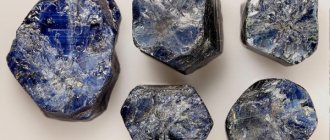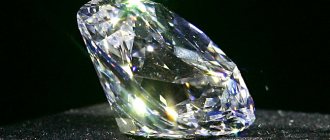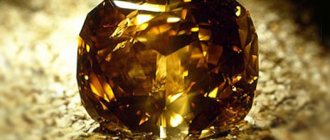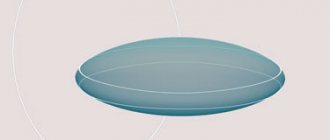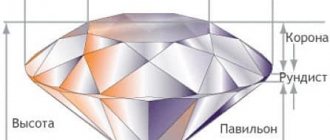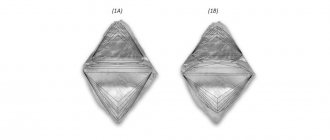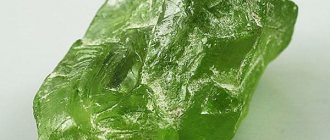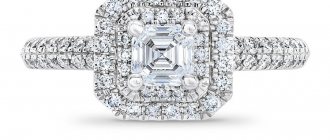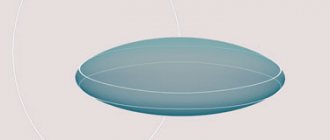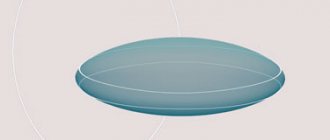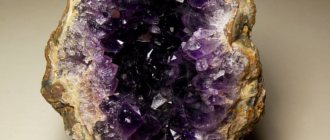History and origin of the name
These super-strong transparent stones were first noticed by the Tamils in Southeast Asia. They gave it the name corundum (translated as ruby). And the Greeks renamed it sapphire, which in their language means “blue gem”. Later we figured out the terminology. Red corundums remained rubies, while corundums of other colors remained sapphires. In Rus' they were called azure yachts and were highly revered.
Sapphire deposits and mining
Sapphires are mined in Thailand, Burma, Vietnam, China, India, Sri Lanka, and Madagascar. There are deposits on other continents (North America, Australia) in places of pegmatite deposits. In nature, the mineral is quite inconspicuous. In Russia, some corundum has been found on the Kola Peninsula and the Urals, but industrial mining is unprofitable.
The best is considered to be the Kashmir sapphire, which has a wonderful cornflower blue color. The deposit in Kashmir (Indian) is not currently being actively developed, so local sapphires are valued not only for their unique properties (the epithets alone are worth it: velvety, hazy, sleepy), but also for their exceptional rarity. Its color is considered the reference; all other shades are described in comparison with it. For example, Ceylon sapphire (Sri Lanka) is paler, and Burmese sapphire is darker than Kashmir sapphire. Sri Lanka supplies jewelers with the rare Padparadscha gem. Star-shaped specimens are also often found here.
Most blue corundum is mined in Thailand. The largest, brightest blue and purest sapphire, the “Jewel of the Jungle,” was discovered here. Its weight, according to the description, is 958 carats.
Physicochemical characteristics
The physical properties of sapphire can be the envy of any gemstone. Hardness on the Mohs scale - 9, density - 4 g/cm3, not brittle, very shiny. Composition: alumina, aluminum oxide. The chemical formula of sapphire is Al2O3. Pure corundum has no color; the blue color is given to it by metal impurities: iron, manganese, chromium, titanium. When heated, the color characteristics of the crystal change: pale ones become even lighter, dark ones turn pink. X-rays enhance the brightness of shades.
What colors and types of sapphire are there?
The color range is wide. Basic: blue sapphire, blue sapphire, cornflower blue. It is these minerals that mineralogists recognize as sapphires. But jewelers also honor stones of other colors. If the specimen contains more than 15 percent of another color in addition to blue, it is a multi-colored polychrome sapphire, otherwise called fancy, with a difficult-to-define color: it can be pink-orange, garnet-red, yellow-blue, dark blue (to black), purple etc. Colorless ones with a milky tint are called leucosapphires. These are former colored ones that have become discolored due to extreme heat. When people talk about black or green sapphires, they are actually talking about the same blue ones, only with “thick” impurities that give the illusion of black or green. There are "star sapphires" - stones with an asterism effect, usually used as cabochons.
There are many types of sapphires, and each deserves close attention. We will talk about gray, brown, lilac, rare purple sapphires, as well as declassified ones in other publications.
How to distinguish from a fake
Natural sapphire stone is expensive and rare, so it is often counterfeited. In addition, methods for producing synthetic corundum have long been invented. How to determine which variety you are dealing with?
The photo below shows an artificial sapphire under a microscope. Its synthetic nature is revealed by bubbles - light and dark dots. An elongated bubble indicates a sapphire grown by the Verneuil method.
Outright fakes include products made of glass, plastic, and cheap minerals. It is not difficult to see the imitation.
- Due to its amazing hardness and density, real stone cannot be scratched by sharp objects. The fake one will have a visible stripe. But who will allow you to scratch jewelry in a jewelry store?
- A sure way to confirm the authenticity of a sapphire is by zoning - the uneven distribution of color in a natural stone. See the video below for more details.
- The gem will remain cool in your hands for a long time. The fake will heat up quickly.
- In bright light and under a magnifying glass, a heterogeneous structure is visible in the original; inclusions, tiny cracks, and chips are possible. The imitation is externally perfect.
- Under an ultraviolet lamp, the fake stone becomes greenish, while the reflections of the natural stone become white.
- If a cheaper gem, the so-called doublet or triplet, is passed off as a sapphire, then a thin layer of natural stone is glued onto the imitation, and the place of gluing is visible under a magnifying glass. A fake or similar semi-precious stone will be easily scratched by a precious sapphire.
- The cost of natural sapphire is high. Suspiciously low - an indicator of a cheap imitation.
Depending on the quality, there can be either a semi-precious or a precious sapphire stone. Cloudy corundum, speckled with cracks, is classified as semi-precious, ornamental, or even
Sapphires of artificial origin (grown) are not considered fake. However, this also does not apply to precious stones. Conscientious sellers do not hide the origin of the stone; they indicate this fact in the certificate, since synthetics are cheaper. It is difficult to find the differences on your own with the naked eye. Under a microscope, the boundaries between the overgrown layers are visible, similar to annual rings on a tree cut. Unless the ideal appearance and too bright shade will arouse suspicion.
Some people confuse sapphire with sapphirine. This is also a light blue colored gemstone. In time immemorial, he was called the “son of sapphire,” although they are not at all similar - neither in appearance nor in structure. Sapphirine is opaque and is classified as an oxide rather than an oxide. Cordierite, which is similar to it, is also not sapphire.
Diamond cut: types, shapes and names
Princess cut diamond
The Princess rectangular cut diamond can also compete in beauty and popularity with the round crystal. This type of processing of jewelry diamonds was developed in the 60s of the twentieth century. But the “Princess” had predecessors - the “Baryon” and “Quadrillion” forms. These forms were carefully perfected by jewelers.
This is how a new type appeared, allowing you to admire a sparkling, acute-angled crystal of a square or rectangular shape. Moreover, Princess diamonds are not inferior in sparkle and play to their round counterparts, and much less source material is lost.
Asscher cut diamond
Another type of processing of diamond crystals in the shape of a rectangle. A worthy alternative to the “Princess”: in fact, this is a variety of emerald cut that has a square shape with truncated corners. This type of diamond cut has 58 facets, but there is also the Royal Asscher cut, which has 74 facets.
Suitable for clean stones without initial flaws, since the peculiarities of grinding and applying facets reveal defects. Whereas in the “Princess” type, all inclusions and scratches are masked.
Cushion cut diamond
Cushion is a quadrangular cut with wide edges and convex sides. The corners are softened and rounded. The girdle is shaped like a cushion, which is why this treatment is called cushion-shaped. The first such diamonds appeared at the beginning of the twentieth century and have been modified in every possible way since then.
Thus, the jewelry fashion house “Tiffany” has developed and uses a variety of “rectangular cushions”. Cushion crystals can differ significantly from each other - after all, when polishing, jewelers strive to preserve the mass of the crystal as much as possible and improve it.
Marquise cut diamond
The sparkling boat-shaped crystals of the Marquise diamond have a beautiful story behind them. Their prototype, the Navette diamond, weighing more than 15 carats, adorned the collection of Cardinal Mazarin. And the beautifully curved stones owe their name to the Marquise de Pompadour herself, a connoisseur of luxury jewelry.
According to legend, Louis XV wanted to present his passionate favorite with a crystal in the shape of her smile. Therefore, fashionable shuttle-shaped diamonds, which are gaining popularity in the 21st century, are a well-forgotten old thing in jewelry. And it’s great that this type has been restored: the oblong shape of the stones allows you to create real masterpieces, as it combines perfectly with crystals of other shapes.
Pear shaped diamond cut
The Pear diamond also has its own beautiful history, which began in the late Renaissance. At that time, two types of stone grinding were popular: “Rose” and “Briolet”. The Briolette shape repeated the outline of a drop.
Apparently, it was “Briolet” that became the forerunner of modern teardrop-shaped processing. The fancy, complex “Pear” has 56 facets and is a combination of a round crystal and the “Marquis” type.
Radiant diamond cut
The Radiant diamond is cut in the shape of a rectangle or square with an octagonal outline. Technologically, it is a combination of step and diamond types of processing. The corners of the crystal are truncated to increase sparkle.
Radiant is a rather rare crystal due to the specific grinding process; it is more often found among colored diamonds, as it improves their color.
These are the main types of processing of jewelry diamonds. But there are also heart-shaped diamonds, triangular ones, and other modifications of classic shapes.
The search for ideal parameters does not stop. The quality of diamond cutting is improving thanks to modern modeling technologies and the invaluable experience of the past.
Who is it suitable for?
The gem is distinguished by the fact that it is equally friendly to any owner. But there are some nuances.
Horoscope
The zodiacal compatibility of sapphire is very wide. Some important notes are presented in the table below.
| Zodiac signs | Compatibility | What does it give to men? | What does it give to women? |
| Aries | +++ | Calms excessive ardor and negative emotions | Will help you find your place in life, explore the world |
| Taurus | + | Protects from negativity | |
| Twins | +++ | Helps you find true friends and regulate your restless disposition | Protects against depression, removes negative energy |
| Cancer | + | Will give good luck, protect from negativity | Will attract positive energy |
| a lion | +++ | Strengthens restraint and thoroughness | Will help you decide in life |
| Virgo | + | Strengthens will and determination | Helps develop communication skills |
| Scales | Determination | Creativity | |
| Scorpion | + | Directs internal energy into a creative direction and protects against negativity | Calms passions and fills life with positive emotions |
| Sagittarius | +++ | Courage, determination | Sexy, charming |
| Capricorn | _ | ||
| Aquarius | + | Will develop oratory skills, protect from evil people | Will give inner relaxation, the ability to empathize, develop intuition |
| Fish | + | Increases internal energy | Balances the state of mind |
Note: +++ fits perfectly; + can be worn; - Not recommended.
Sapphire for Leo is an opportunity to neutralize vanity and pride in oneself, if any. The stone will increase your diligence and help you achieve your goals. It is better to have yellow and pink sapphires.
Sapphire's zodiac sign does not suit Capricorn. However, representatives of this sign can also wear a wonderful stone if a clear connection is felt with a specific piece of jewelry, and the owner himself is a balanced person.
By name
To whom are the properties of the sapphire stone most suited by name?
By choosing him as a talisman, Antonina can hope for reciprocal love.
Lyudmila will become more flexible, more compassionate, wiser.
The gem will bestow the favor of fate on Rose.
It will help Gregory make friends, protect him from temptations, and relieve him from internal turmoil.
Egor will be given the favor of fate and prudence.
It will add modesty to Kirill, teach him loyalty and the desire for justice.
With his help, Stepan will be able to comprehend his life goal, to know himself.
Regardless of the name, the talisman gives the owner secret power over people, the desire to acquire new knowledge, useful experience, like-minded people, and makes life easier. But its owner must be pure in thoughts.
With other stones
Sapphire looks best alone or in combination with diamonds.
It is also magnificent when surrounded by rubies, amethysts, garnets, cubic zirconias. In terms of energy (and style), pearls and other opaque stones are not suitable for him. It should not be combined with malachite and beryl. As for the setting, sapphire looks ideal in silver, gold and platinum. Silver gives it severity, purity, sublimity. Gold and platinum ennoble even more, making it truly regal.
Diamond cut shapes
Choosing the shape of a diamond cut is the most important part in the cutting process. It is very important to choose exactly the contour that can clearly and flawlessly reveal to the human eye all the advantages of the stone, and at the same time hide all the shortcomings from it. At the moment, fantasy and classic round contours are widespread in jewelry, which can be found in 70% of precious products.
Round diamond cut
The round diamond cut is the most common shape of this gemstone. Its outlines not only look very beautiful and harmonious in exquisite jewelry, but also qualitatively reveal the jewelry characteristics of the gem. On the surface of such diamonds, you can see the most colorful play of light in multi-colored highlights. As for the visual depth, it will amaze even the most sophisticated jewelry connoisseurs. In addition to its positive characteristics, the round shape of this gemstone is also one of the most expensive. This is explained by the fact that diamonds with such outlines do not exist in natural conditions. Therefore, when processing stone, a significant part of its mass is lost, which affects this pricing.
A round gemstone has from 57 to 58 shining facets. Of these, 33 bevels belong to the crown, and 24/25 belong to the pavilion (the lower part of the diamond).
Oval cut
The oval shape of diamond cuts has the same processing principle as that applied to a classic round stone. But at the same time, diamonds have more elongated outlines, which have about 57 facets.
Oval minerals have a wide crown area, which creates a play of light similar to a round stone. But externally, an oval diamond seems much larger and more impressive than a classic one and is great for inlaying rings, rings and pendants.
Princess cut
The princess cut diamond is a mixed-cut creation, and one of the finest types of this gemstone. In its outline, the princess diamond resembles a fragment of a natural diamond with eight facets, and does not require significant losses in weight during cutting. The number of facets reaches up to 68.
Unlike round diamonds, the play of multi-colored highlights of the princess unfolds in its very depths. This quality shrouds the stone in a haze of mystery, and its more affordable price is winning more and more fans.
Boilliant heart cut
A heart-shaped gem tells the story of love better than any other gemstone. Perfect as a gift for your significant other on Valentine's Day, a wedding anniversary, or simply as a sign of priceless attention.
Cutting a heart-shaped diamond is not an easy task. It has almost the same cutting principle as the classic round one, and has 57/58 facets. Accordingly, such jewelry work is highly paid. Therefore, if you want to purchase such a jewel, then be prepared to fork out a lot in advance.
With the help of a heart shape, diamonds also perfectly hide defects, and the play of their highlights is almost comparable to a round diamond. But before you buy such jewelry, carefully examine its quality. The heart-shaped shape is one of the most complex diamond contours, during the processing of which errors are most often made that discard the gemstone.
Pear cut
The pear-shaped silhouette of the gem looks very elegant in women's jewelry, especially in pendants, rings, rings and earrings. The pear cut has a rich history, because it comes from a diamond shape of the distant 16th century, called briolette.
Modern pear-shaped diamonds are teardrop-shaped and contain about 56 surface cutting planes.
Marquise diamond cut
A marquise is an elongated diamond that is made primarily from oblong diamonds.
The Marquis received its name in honor of the brilliant smile of the beautiful Marquise de Pompadour, the mistress of Louis 15 and a bright historical figure of Great Britain. History has preserved the legend of how a king in love once promised to give his favorite a precious gem that would be able to show her smile the way Louis himself saw it.
When looking at the luxury of the Marquis, the question involuntarily arises: how many facets do Madame de Pompadour’s diamonds have? The correct answer is 55.
In combination with jewelry, Marquise looks most advantageous in women's rings and rings. The oblong mineral visually lengthens the fingers and gives them a slight charm.
Emerald cut
Emerald is produced using step-cut diamonds. Its characteristic features are smoothed corners and a rectangular octagonal contour. Has from 57 to 65 edges. The play of glare here is less pronounced than that of a princess or a round diamond. But the flashes of light on its surface become larger and brighter.
Emerald can only be applied to diamonds of perfect purity and impeccable quality. Otherwise, all their hidden defects will be exposed on display.
Radiant cut
The Radiant, like the Princess, is a mixed-cut creation. In terms of external characteristics, it is something between an emerald and a princess. The corners are smoothed, the outlines have an octagonal outline, the number of facets reaches 65. Most often, the radiant is chosen for processing multi-colored oblong diamonds.
Rings and rings inlaid with radiant look aristocratic, impressive and elegant. Such jewelry is widely in demand among men. A similar shape is also used in earrings and pendants. In order to insert a radiant into a piece of jewelry, special teeth are installed in the niches under the stone to strengthen it.
Asscher cut
The Asscher is distinguished by its square shape, which resembles a combination of emerald and radiant. The sides of the gemstone must have a perfectly even ratio. The diamond received its name in honor of its developers, the Asher brothers.
Asscher has wide and open facets in the amount of 65, so, like emerald, it is only applied to high-quality diamonds.
Trilliant cut
The youngest of all diamond cuts is the trilliant. Such a jewel first saw the light of day under the skies of Amsterdam, about thirty years ago. It has the outline of a triangle with equal sides. In jewelry it is most often used as a composition for the central gem. We have listed the main shapes of diamond cuts.
How many faces diamonds have with triangular contours largely depends on the master’s design. There are no standards for the production of trilliant yet. Basically, these gemstones have from 65 to 74 facets.
Magic properties
Sapphire is a stone endowed with many magical properties. Stellar corundum is especially strong, on the surface of which a three- or six-rayed star glides.
The stone is considered a symbol of power. The person who owns it is unconditionally recognized as a leader and controls the masses. And this is understandable, because: it strengthens masculinity, forms a wise perception of life, helps to recognize the essence of other people’s judgments, strengthens the nervous system, protects against the consequences of envy, the evil eye and witchcraft. Being a strong talisman, it warns of danger threatening the owner, attracts like-minded people and drives away enemies. It is believed that this stone chooses its owner. His appearance is considered a gift from heaven.
All sapphires have magical properties, but their effect also depends on the setting. A stone in silver gives restraint, composure, and wisdom. Set in gold, it conveys courage, determination, and a victorious attitude.
The energy direction is determined by the color of the stone.
- Yellow. It is recognized as a stone of creators because it gives inspiration and activates dormant supernatural abilities. Brings harmony into family life, promotes mutual understanding between spouses. The yellow gem accumulates goodness and at the right moment shares it with the owner, relieving him of depressive moods and stress.
- Blue. It treats physical rather than mental ailments more successfully: it strengthens the heart and eyesight. If it is also a star stone, it helps to find and keep love. Good for scientists seeking to understand the secrets of the world. Facilitates learning and develops mental abilities. An equally valuable quality is to guide a person along the right path in life and strengthen leadership abilities.
- Black. It will protect you from enemies, make you believe in yourself, give you determination, protect you from negativity and depression, and attract financial well-being. This stone is especially valued by magicians and is used in various rituals. It is believed that sapphire connects the worlds and comes to the rescue when communicating with otherworldly forces.
- Blue. Supports and develops abilities, including extrasensory ones, opens the “third eye”, develops the mind, and promotes choice in a difficult situation.
- White. Helps achieve a goal, especially if it concerns the spiritual sphere.
- Green sapphire is a reconciliation stone. It reconciles warring relatives, smooths out rough edges in relationships between people, eliminates selfish tendencies, and promotes memorization and interpretation of dreams.
- Pink protects young people, especially girls, from temptations. At the same time, it attracts a passionately adored person of the opposite sex to the owner.
- Star sapphires can protect against deception.
Sapphire can be used as a love spell.
Color does not matter in this case. Place the stone in a glass of wine, cover it with your palms and think about your loved one. They go to bed with these thoughts. In the morning, the stone is taken out and the object of one’s love is given to drink the wine. The effectiveness of such a recipe when executed by an ignorant person is zero, but the karmic consequences for trying to violate the will of another person will definitely have to be experienced by yourself after some time. The magical properties of sapphire should be used only for good purposes. The stone will become a faithful assistant, an excellent amulet and a talisman for a person with pure thoughts. It will protect the owner from damage and the evil eye, breaking the insidious thoughts of ill-wishers. It will warn the owner about the danger that threatens the owner with its tarnishing.
For women, the gem is good because it makes them more attractive, brings harmony, tranquility, and fidelity to family life. Jewels that are passed down from generation to generation have special power.
Men under the influence of sapphire calm down, become more reasonable, and more tender with their spouse. If we are talking about a male leader, the stone helps him competently lead the team, be more decisive, and more purposeful.
It is recommended to take the stone on trips as a talisman against any misfortunes.
Marchioness Guinness Kashmir sapphires to be auctioned
A brooch that belonged to Maureen Constance Guinness will become the top lot at Sotheby's jewelry auction in Geneva.
For gemstone connoisseurs, there are conventions that guarantee the high quality of the stone... and its fabulous price. Golconda (for diamonds), Burma (for rubies), Colombia (emeralds) and Kashmir, which refers to the origin of the sapphires from a region in the Himalayas of northern India in the late 19th century. Kashmir sapphires are among the rarest colored gemstones on the planet. They are much rarer than, for example, D-grade diamonds, which means they are among the most expensive.
After a landslide in the region discovered sapphire deposits in the rocks, the stones were actively mined for only five years - from 1882 to 1887, after which the deposit was exhausted. Despite numerous attempts, no one has since been able to restore the source. So there are a limited number of these deep cornflower blue stones in the world. As soon as these stones appeared on the European market at the end of the 19th century, their quality became immediately clear, surpassing the quality of sapphires from other deposits.
You can be sure that the brooch with Kashmir sapphires, which Sotheby's will present at the Magnificent Jewels jewelry auction on May 11, will be a rare chance in the next few decades to see stones of this quality and size being sold at auction. In this 1930s brooch, a 55.19-carat oval Kashmir sapphire, the largest of its kind ever to appear at auction, sits alongside another of the same origin, weighing 25.97 carats. The stone is elongated, oval in shape, most likely, it was cut in such a way as to retain maximum weight from the original crystal. It will certainly attract the attention of the largest collectors - both private individuals and representatives of the jewelry industry, interested in changing the cut to improve the color of the stone.
The brooch belonged to Maureen Constance Guinness, Marchioness of Dufferin and Ava, an Anglo-Irish socialite and member of a brewing dynasty, whose grandfather was Edward Guinness, 1st Earl of Iveagh, managing director of the family business in the late 1800s and Ireland's richest man. Maureen and her sisters Eileen and Ona were known as the "Golden Girls of Guinness", prominent members of London society, and it was Maureen who was noted for her extravagant style of dressing. After graduating from school in Paris, she first appeared in society in 1925, married three times and was one of the first women on the board of directors of Guinness Brewery.
The provenance of a piece of jewelry from an important collection always attracts the attention of collectors who value provenance. The two sapphires in the brooch have been in the collection of the Guinness family since the end of the 19th century, immediately after they were mined. They were installed in the brooch in the 1930s. Since the brooch is without a hallmark, Sotheby's experts attribute it to Cartier, since the Guinness family had a tradition of ordering jewelry from these jewelers. The estimate for the brooch was $2–3 million.
Stones of this size are phenomenally rare. Since 2015, only ten Kashmir sapphires weighing more than 20 carats and only five weighing more than 30 carats have appeared at auction, so the juxtaposition of these two with a total weight of more than 80 carats is impressive.
In 2013, the auction house sold earrings containing a pair of 26.66- and 20.88-carat Kashmir Richelieu sapphires and diamonds for $8.4 million, the second highest price paid for sapphire jewelry. The world record belongs to a Ceylon sapphire of 392.52 carats, sold for $17.6 million at Christie's Geneva auction in 2014. The world record price for a single Kashmir sapphire belongs to a 35.09-carat cushion-cut stone set in a ring and sold for $7.4 million at Christie's Geneva auction in May 2015. And the latest world record in the price per carat category belongs to a Kashmir sapphire weighing 27.68 carats, set in a ring and sold at Sotheby's Hong Kong auction in October 2015 for $6.7 million ($243,703 per carat).
Two Colombian emeralds weighing 80.45 and 104.4 carats will appear at Sotheby's Magnificent Jewels auction on May 11, 2021
Photo: Sotheby's
Sapphires aren't the only big stones expected at auction this spring. The Magnificent Jewels and Noble Jewels auction in Geneva on May 11 also includes a pear-shaped Colombian emerald weighing 104.4 carats, Ceylon sapphires weighing 111.73 carats and 126.43 carats and two D Type IIa diamonds weighing over 40 carats. All stones come from important and aristocratic collections, the exact provenance of which is still kept secret.
Ekaterina Ziborova
Medicinal properties
Healers have long studied the healing properties of sapphire, discovering new ones. Traditionally, it is recommended to use the stone to enhance the treatment of heart ailments, asthma, skin diseases, diabetes, migraines, kidney diseases, musculoskeletal disorders, and mental disorders. It is customary to take into account the color of the mineral, since stones of different colors have their own specific characteristics.
- Yellow helps fight depression, stress, strengthens the immune system, and has a positive effect on all body systems. It is not recommended to constantly wear a stone or jewelry made of yellow sapphire, as the strong energy of the mineral can cause anxiety.
- Green protects against insomnia and nightmares. Just put it under your pillow at night. Like most green gems, it promotes visual acuity.
- Blue helps in the treatment of skin rashes and reduces inflammation. Especially indicated for heart patients. Helps recover from heart attacks and strokes. Relieves severe headaches.
The properties of sapphire stone are clearly manifested for women, as it helps treat gynecological diseases and relieves reproductive problems.
The healing properties of the gem were admired in Rus'. They called it “wise” because they were sure that it strengthens memory, helps to remain sane until old age, promotes the thinking process, and even rejuvenates the body. Healers from other countries also speak about the ability of sapphire to fight sclerosis and senile insanity. It is called a stone of longevity because it stabilizes blood pressure, partially neutralizes the adverse effects of solar activity on the body, and strengthens the general well-being of older people.
It is recommended to wash your face with sapphire water. To do this, early in the morning a crystal is dipped into the liquid for two hours. Infused water relieves inflammation, tightens the skin, and treats eye diseases. A migraine attack will subside if you apply a compress with sapphire water to your forehead.
Uncut stones are more suitable for medicinal purposes.
Modern people's belief in the healing properties of sapphire is not as strong as in ancient times. But, you must admit, even the simple contemplation of a precious stone of amazing beauty and magical reflections of light on its many facets calms and pacifies. And quality relaxation promotes health.
How to wear and care for sapphire
Astrologers advise buying jewelry on the 8th lunar day, and putting it on for the first time on the 22nd. On which finger to wear a sapphire ring? On the index hand of the right hand, then the stone will maximize its best properties: bring good luck, prosperity, make a person wiser and more resilient.
An engagement ring with blue corundum will bring good luck in your family life. In case of an accidental disagreement with your spouse, you need to put a ring on the ring finger of your right hand so that the problem goes away.
For men, large rings, matching cufflinks, and tie pins with a dark-colored stone are suitable.
Brunettes look good with deep blue stones, while blondes look good with light ones.
A modest ring with a medium-sized sapphire placed on your finger looks appropriate in the office. It can be set in silver or white gold. For special occasions, large jewelry is chosen.
For a piece of jewelry to delight its owner with its pristine beauty for many years, little is required:
- avoid falling stones, any strong mechanical impact, interaction with chemicals, cosmetics;
- remove jewelry when performing household chores (laundry, washing dishes, cooking);
- do not swim in it, do not stay in direct sunlight for a long time;
- store separately from other jewelry in a box upholstered in soft fabric;
- clean with a soft cloth in a soap or saline solution, then rinse with clean water.
With proper care and careful storage, the precious jewelry will become a family heirloom and will be gratefully received by the heirs.
